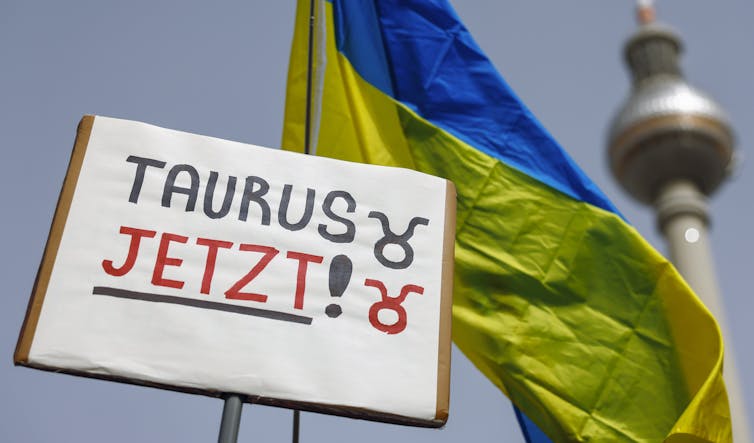The frontlines within the Russo-Ukrainian battle have largely been slowed down, with little vital motion on both aspect. It was reported lately that Russian troops had solely superior about 25 miles within the japanese sector close to Donetsk in a single 12 months, at an enormous price by way of casualties. In consequence, either side have sought alternative ways of making an attempt to realize a strategic benefit over their opponent.
Air energy has lengthy been a recognised approach of restoring a level of mobility to the battlefield. However in Ukraine, neither aspect has been in a position to obtain management of the air, because of the standard of their air defences. So as an alternative, either side are utilizing drones for “tactical” (small-scale) impact.
At this level, it’s value specializing in the three ranges of warfare: tactical, operational and strategic. The chart under, taken from the US Navy Overview, illustrates how these ranges work – working as a “distinct hierarchy with marginally overlapping areas between the strategic and the operational, and between the tactical and the operational”.
Military College Press
The tactical stage is the place small actions are deliberate and executed. On the operational stage, main operations and campaigns are deliberate with a view to reaching strategic aims. The strategic stage includes longer-term methods to attain the overarching political aims of a battle.
Russia’s capacity to deploy long-range missiles and longer-range drones (such because the Shahed 136) that may strike targets – each army and civilian – deep inside Ukraine, has given it a strategic benefit.
There are two strategic goals to those strikes. The primary is to scale back Ukraine’s capability to supply army tools by its home industrial base. The second is to focus on city areas and civilian populations to undermine public morale – though how efficient that is has lengthy been a matter for debate.
Benefit Russia
The prohibition on Ukraine utilizing weapons provided by its allies to strike targets in Russia has put it at a substantial drawback – which means that Ukraine’s army has been unable to take advantage of these weapons’ full potential. So, Russia has been in a position to construct a substantial army/industrial base with out menace of assault.
However now, the choice to raise these restrictions by the UK, US and, most lately, Germany will permit Ukraine to assault a wider vary of targets and create extra strategic difficulties for Russian political and army management.
Particularly, it’s value highlighting the latest assertion by the German chancellor, Friedrich Merz, who introduced on Could 28 that Berlin would assist Kyiv develop new long-range weapons that may hit targets in Russian territory.

EPA-EFE/Hannibal Hanschke
To what extent Ukraine will be capable to exploit this better latitude to assault targets inside Russia stays to be seen. However the prospect of long-range missiles getting used towards its cities – the German Taurus missiles have a spread of greater than 500km – might give Ukraine a level of leverage in any recent peace talks.
The lifting of those restrictions is unlikely to make a lot distinction on the bottom for a while, although. Whereas theoretically, Ukraine will be capable to strike at a few of Russia’s army manufacturing websites, Russia has dramatically overhauled its arms manufacturing capability. Nato’s high US commander is reported to have lately informed a Senate Armed Providers Committee that Russia is “on monitor to construct a stockpile thrice better than the USA and Europe mixed”.
No restrictions – for now
It’s additionally value noting that each the US and UK signalled their willingness to permit their long-range missiles to strike at missile launchers inside Russia late final 12 months as a defensive measure – however on a restricted scale and solely utilizing domestically produced weapons, in distinction to the assaults carried out by Russia.
What’s completely different in the newest announcement is the lifting of restrictions on what could be focused with weapons supplied by western allies, relatively than these domestically produced by the Ukrainian defence trade. That is an extension of an preliminary lifting of restrictions in late 2024
by the US and UK, additional broadening the targets that may be attacked.
However the leisure of those restrictions may very well be reversed in a short time if Ukraine launches large-scale strikes towards civilian populations – which might generate extremely opposed publicity for Ukraine and the international locations that provided the weapons.
Russia’s concentrating on of Kyiv in latest weeks has been bitterly criticised by the US president, Donald Trump, who posted on his TruthSocial web site lately: “[Vladimir Putin] has gone completely loopy. Needlessly killing lots of people.”
However Kyiv’s allies will even be cautious of how Russia might react. Russia has at all times threatened dire penalties if Ukraine makes use of western-supplied weapons to launch assaults inside Russia.
Certainly, the political ramifications of the lifting of restrictions are more likely to be extra consequential than the army outcomes – for now, at the very least.



















